
Australian designer's wearable tech that doesn't look or feel like tech
We:eX's innovations include a jacket which tells you where to go while jogging by tapping you on the shoulder


Yoga pants that improve your practice, running jackets that tell you which street to take: Wearable tech is moving way beyond a strap on your wrist, and Aussie designer Billie Whitehouse is helping drive it.
The 29-year-old Sydney-native made her name with Fundawear: underwear that allowed the sensation of physical touch to be transmitted from one person armed with a smartphone to another person wearing the garments.
Whitehouse designed Fundawear in 2013 with Ben Moir, an electrical engineer, as part of an advertising campaign for condom-makers Durex - a campaign that ended up winning a Silver Lion at the prestigious Cannes Lions festival.
The enthusiastic response to Fundawear prompted Whitehouse and Moir to set up Wearable Experiments (We:eX), a wearable tech start-up, to create products for retail sale, with funding assistance via a partnership the company signed in March with Sri Lankan apparel manufacturer MAS Holdings.
The Nadi yoga pants and the Navigate jacket are two such retail products, with both due to go on sale online and in some retail stores later this year. We:eX said it had not set the pricing for the items as yet.
Whitehouse says it is key We:eX clothing improved the wearer's quality of life by addressing practical issues, such as the danger of jogging on city streets.
"I found that I nearly got hit by taxis, I nearly got hit by other people," she said. "This to me was one of the most intuitive products we've built because you upload from your smartphone, like you would in Google Maps, where you'd like to travel to and then instead of staring down at that map and not knowing when to turn left or right, the jacket will tap you on the shoulder when to turn left, when to turn right, and then double time when you arrive."
We:eX's clothes use hapic feedback, which is a technology that recreates the sense of touch by using vibration or pressure, with the skin as an interface. It's used in smartphones such as Samsung's Galaxy S, which vibrates when a user touches the phone interface.
For example, We:eX's Nadi yoga pants work with a mobile app to monitor the wearer's form when executing a pose, vibrating at varying intensities to let the wearer know when they have the pose correct.
Whitehouse said We:eX was also focused on making sure its clothes looked good, as well as being practical.
"My background is actually in fashion, and I think what we did differently with Fundawear and with all our products, is that none of these products look or feel like technology products," she said.
"They very much look and feel just like a normal pair of pants or a normal pair of underpants or a normal fan jersey, and for us that was part of the excitement - tech not looking and feeling like tech."